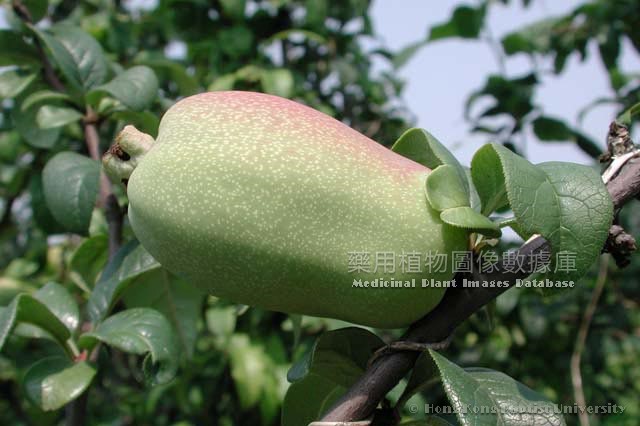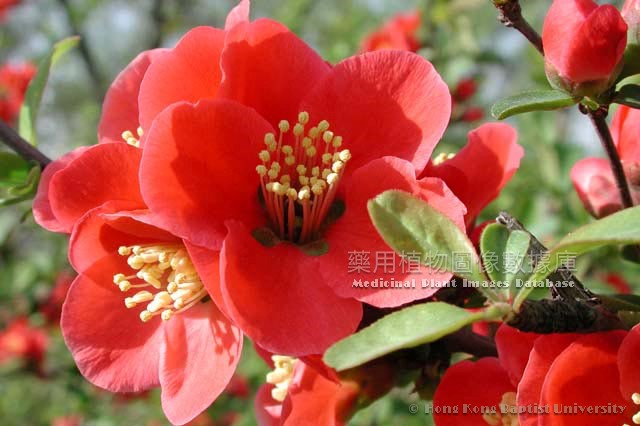|
Chaenomeles speciosa (Sweet) Nakai


|
English Name |
Common Floweringquince, |
|
Latin name |
Chaenomeles speciosa (Sweet) Nakai |
|
Family & Genus |
Rosaceae, Chaenomeles |
|
Description |
Deciduous shrubs, 2-3m tall. Branches erect expanded, brown, spinescent, young branches densely covered with dirty yellow hair, becomes thorny at top, lenticel prominent. Leaves coriaceous, usually 4-7 fascioled at spur shout; petiole 3-15mm long; stipule not prominent, nearly round, usually shed; leaves ovate to elliptic-lanceolate, 3-12cm long, 1-3cm wide, apex acute or obtuse, base wide cuneate to nearly round, margin densely irregular sharp serrations, dark green above, glossy, pale green below, glabrous both sides, or light brown hairs below the vein when young. Flowers fascioled, one to two anomaly leaves under inflorescence; pedicel very short; calyx tube 2-3cm long, green and purple-red, with white powder, calyx 5, ovoid-triangular, erect, purple, ca. 5mm long, yellow long hairs inside and margin; petals round, crimson, also white or pink, nearly round, with short claw, up to 2cm in diam., stamens ca. 30, ca. 14mm long, purple, filament long and thin, anthers oblong, t-shaped; pistil 1, inferior ovary, 5 chambers, styles 5, a bit combined below, sparsely pubescent, as long as stamens, stigma densely papillary. Pome ovate or spherical, ca. 8cm, yellow or yellow-green, aromatic. Seed flat, likely triangle. Flowering: March to May, fruiting: September to October. |
|
Distribution |
Growing on slopes, forest edges and roadsides. Can be cultivated. Distributed in east, middle and southwest of China and other places. The medicinal materials are mainly produced in Anhui, Sichuan, Hubei and etc. |
|
Part Used |
Medical part: nearly mature fruits. Chinese name: Mugua. |
|
Harvest & Processing |
Harvested greenish yellow fruits in summer and autumn, scalded until skin grayish white, vertically cut into halves, and dried. |
|
Chemistry |
Contains sucrose, reducing sugar, malic acid, citric acid, ascorbic acid, tartaric acid, amino acid and tannins, etc. |
|
Pharmacology |
Hepatic-protective and antibacterial. |
|
Properties & Actions |
Sour, warm.Pacifying the liver and relaxing sinews, harmonizing the stomach and resolving dampness. |
|
Indications & Usage |
Used for damp arthralgia and contractions, heavy feeling and pain in the waist and knee joints, vomiting and diarrhea, muscle spasms, beriberi and edema.Oral administration: decocting, 6-10g, or made as pills or powders. External application: appropriate amount, decocted for fumigating the affected parts or smashed for application. Use with caution in cases of excess dampness and heat. No more than prescribed. |
|
Examples |
1. Rheumatism, unable to superduct hands, feet, waist and knee: papaya 1, qinghai salt 15g. Remove peel and areola, open and fill with medicinal evodia 30g, remove branches, tie with thread, steam hot and grind into fine powder, add qinghai salt 15g, grind into fine powder, prepare pills as large as firmianae semen, take 40 pills each time, swallow with tea or liquor, or best when swallowed with two-toothed achyranthes immersed in liquor and drink. Take before meals.
2. Dysentery with red and white feces: papaya, plantain seeds, opium poppy shell of equal amount. Grind the above drugs into fine powder, take 6g each time, and swallow with washed water of rice. |
| Link to |
 Chinese Medicinal Material Images Database Chinese Medicinal Material Images Database
 Chinese Medicine Specimen Database Chinese Medicine Specimen Database
|
|

